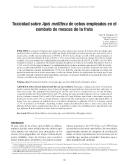| dc.description.abstract | Se comparó el impacto que tienen los cebos tóxicos para moscas de la fruta sobre las abejas, Apis mellifera. Para el análisis estadístico, se utilizó un diseño bifactorial con cuatro niveles por cada factor. En el factor cebo, el cebo con malatión mató el 30,93 por ciento y 38,13 por ciento de las abejas a las 24 y 48 h, respectivamente el cebo con el colorante floxina B mató el 0,94 por ciento y 7,5 por ciento en los mismos períodos de tiempo. En el factor tiempo residual, a los cero minutos de residualidad la mortalidad de las abejas fue de 25,63 por ciento y 29,38 por ciento a las 24 y 48 h. Cuando las abejas se expusieron 60 minutos después de aplicar los cebos, la mortalidad disminuyó a 0,32 por ciento y 3,13 por ciento a las 24 y 48 h, respectivamente. La combinación de los factores anteriores que mató el 100 por ciento de las abejas fue el cebo con malatión y cero minutos de residualidad. El cebo con el colorante floxina B más tóxico fue a los cero minutos, con una mortalidad de 17,5 por ciento a las 48 h. De acuerdo con estos resultados, los cebos con malatión tienen un efecto tóxico mayor que el cebo con floxina B sobre las poblaciones de abejas, por lo que es posible sustituir el malatión como ingrediente activo por el colorante floxina B en la mezcla de cebos tóxicos para el combate de moscas de la fruta. This paper evaluates the effect of toxic baits used to control fruit flies on honey bees. A factorial design was used with two factors (toxic bait and time), of four levels each. The malathion bait killed up to 30.93 percent and 38.13 percent of honey bees at 24 and 48 hours, respectively phloxine B bait killed 0.94 percent and 7.5 percent during the same periods. Exposure of bees to phloxine B bait at 0 minutes caused 25.63 percent and 29.38 percent mortality at 24 and 48 hours, and at and at 60 minutes mortality declined to 0.32 percent and 3.13 percent at 24 and 48 hours, respectively. The combination of factors that killed 100 percent of honey bees was exposure to malathion bait at 0 minutes. Exposure to phloxine B bait at 0 minutes caused 17.5 percent of mortality in 48 hours. According to these results, malathion baits have a more toxic effect than phloxine B baits on bee populations therefore, it is possible to replace the malathion active ingredient for the dye phloxine B in the mixture of toxic baits for fruit fly control. | es_ES |


